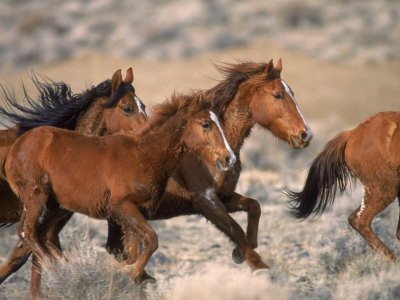Pictures of Horses Running Definition
Source(Google.com)
"Quadruped. Graminivorous. Forty teeth, namely twenty-four grinders, four eye-teeth, and twelve incisive. Sheds coat in the spring; in marshy countries, sheds hoofs, too. Hoofs hard, but requiring to be shod with iron. Age known by marks in the mouth."
-quote from Hard Times by Charles Dickens.
Horses are described in numerous ways; breeds, types, 'bloods' and purposes.
Breeds of horse are distinct genetic entities. Morgan horses will produce
further Morgans, however if two cobs are bred together they may not necessarily produce further cob type horses. They may produce horses of a variety of types dependent upon the various breeds that produced the two cobs in the first place.
Horses are mainly used for hobby purposes, ie. riding (obstagles and dressage) and driving. In some places (Finland and sweden for example) some equine schools use horses for work too.
Communication skills are known to be highly developed in horses, but they are unable to speak to us in the same way that human beings do. It is vital that horse owners understand the fundamentals of horse care and horsemanship. A rider MUST know his/her horse well before attempting anything more than walking with it. Horses are very intelligent and have an excellent memory. You mistreat a horse once, he might kick you in the head 5 years later :)
horses are livestock. Traditionally, and legally, horses have been considered livestock in the United States. Even today, horses are still kept and raised on a farm or ranch and are used in a commercial enterprise. The United States horse industry is a major business that makes a significant contribution to the economic well-being of the entire country. The U. S. horse industry has a $112.1 billion impact on the U. S. economy; generates 1,404,400 full-time equivalent jobs; and pays $1.9 billion in taxes to all levels of government.
The care and regulation of horses and horse related activities come under the purview of the United States Department of Agriculture on the national level. In most states, the state department of agriculture is charged with the regulation of horse related activities on the state level. Part of the responsibility of the USDA is to improve and maintain farm income; develop and expand markets abroad for agricultural products; protect the soil, water, forests, and other agricultural products; and carry out agricultural research.
The USDA provides valuable technical expertise and monetary support for such things as research into the prevention of equine diseases such as Equine Viral Arteritis (EVA), Vesicular Stomatitis Virus (VSV), Venezuelan Equine Encephalomyelitis (VEE), and Contagious Equine Metritis (CEM); the enforcement of the Horse Protection Act; and development and enforcement of the Safe Commercial Transportation of Equine to Slaughter Act. Many state departments of agriculture are also providing valuable assistance to the horse industry through research and regulatory programs. If livestock status is taken away from horses, there is a possibility of losing the already limited financial support equines receive from the USDA for research, regulation, and disaster relief.
Pictures of Horses Running Images Wallpapers Photos 2013

Pictures of Horses Running Images Wallpapers Photos 2013

Pictures of Horses Running Images Wallpapers Photos 2013

Pictures of Horses Running Images Wallpapers Photos 2013

Pictures of Horses Running Images Wallpapers Photos 2013

Pictures of Horses Running Images Wallpapers Photos 2013

Pictures of Horses Running Images Wallpapers Photos 2013

Pictures of Horses Running Images Wallpapers Photos 2013

Pictures of Horses Running Images Wallpapers Photos 2013

Pictures of Horses Running Images Wallpapers Photos 2013

Pictures of Horses Running Images Wallpapers Photos 2013
No comments:
Post a Comment